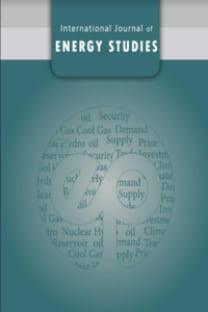Effect of helium dilution on the dynamic stability of lean premixed methane flame in a model gas turbine combustor
Effect of helium dilution on the dynamic stability of lean premixed methane flame in a model gas turbine combustor
Methane Combustion Instabilities, Helium Dilution,
___
- [1] Lundegard PD. Environmental Forensics – Contaminant Specific Guide / Methane. Academic Press 2005:97-110.
- [2] Wang Y, Zhang X, Li Y. Numerical simulation of methane-hydrogen-air premixed combustion in turbulence, International Journal of Hydrogen Energy 2022. In press.
- [3] Guessab A, Abdelkader A, Mansour C, Baki T. Combustion of Methane and Biogas Fuels in Gas Turbine Can-type Combustor Model, Journal of Applied Fluid Mechanics 2016; 9(5): 2229-2238.
- [4] Liu X, Bertsch M, Subash AA, Yu S, Szasz RZ, Li Z, Petersson P, Bai XS, Alden M, Lörstad D. Investigation of turbulent premixed methane/air and hydrogen-enriched methane/air flames in a laboratory-scale gas turbine model combustor, International Journal of Hydrogen Energy 2021; 46(24): 13377-13388.
- [5] Valera-Medina A, Marsh R, Runyon J, Pugh D, Beasley P, Hughes T, Bowen P. Ammonia–methane combustion in tangential swirl burners for gas turbine power generation, Applied Energy 2017; 185(2): 1362-1371.
- [6] Chouraqui H, Dayma G, Ribert G, Halter F, Chauveau C, Dagaut P. Experimental and numerical studies of the diluent influence (N2, Ar, He, Xe) on stable premixed methane flames in micro- combustion, Proceedings of the Combustion Institute 2021; 38(4): 6753-6761.
- [7] Yılmaz I, Cam Y, Alabas B. Effect of N2 dilution on combustion instabilities and emissions in biogas flame, Fuel 2022; 308: 121943.
- [8] Tao C, Zhou H. Dilution effects of CO2, Ar, N2 and He microjets on the combustion dynamic and emission characteristics of unsteady premixed flame, Aerospace Science and Technology 2021; 111: 106537.
- [9] Fan A, Xiang Y, Yang W, Li L. Enhancement of hydrogen combustion efficiency by helium dilution in a micro-combustor with wall cavities, Chemical Engineering and Processing – Process Intensification 2018; 130: 201-207.
- [10] Kozubkova M, Kozubek E, Nevrly V, Bitala P, Stepanek O, Dlabka J, Vasinek M, Bojko M, Zelinger Z, Kubat P, Grigorova E. The Effect of Nitrogen and Argon Dilution on Methane Oxidation in Laminar Flames, Procedia Engineering 2012; 42: 1826-1839.
- [11] Zhang J, Mi J, Li P, Wang F, Dally BB. Moderate or Intense Low-Oxygen Dilution Combustion of Methane Diluted by CO2 and N2, Energy&Fuels 2015: 29(7); 4576-4585.
- [12] Mishra DP. Experimental combustion: an introduction. 1st ed. CRC Press; 2014.
- [13] Wang M, Zhong Y, Deng K. Experiment investigation of the effects of hydrogen content on the combustion instability of methane/hydrogen lean premixed swirl flames under different acoustic frequency ranges, AIP Advances 2019; 9:4.
- [14] House JE. Inorganic Chemistry / Chapter 15 - Chemistry of nonmetallic elements III. Groups VIA-VIIIA, Acedemic Press, 2020.
- Yayın Aralığı: Yılda 4 Sayı
- Başlangıç: 2016
- Yayıncı: Türkiye Enerji Stratejileri ve Politikaları Araştırma Merkezi (TESPAM)
Berk SÜRÜCÜ, Murat ÖZTÜRK, Erdem ÇİFTÇİ, Azim Doğuş TUNCER
Decontamination applications in primary circuit equipment of nuclear power plants
The challenges and serviceability of solar power: suggestion on solving the Nigeria energy crisis
Ayşe TANSU, Ayomide Titus OGUNGBEMİ, Fatma TANSU HOCANIN
Production and determination of properties of ethanol from mango and orange peels
Anas BALA, Richard Balthi MSHELİA, Jamilu Ya'u MUHAMMAD, M ADAM
